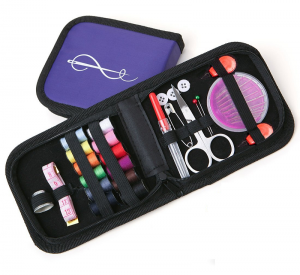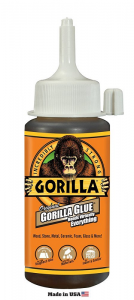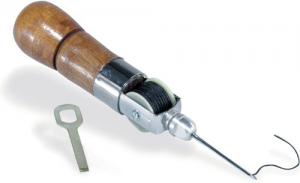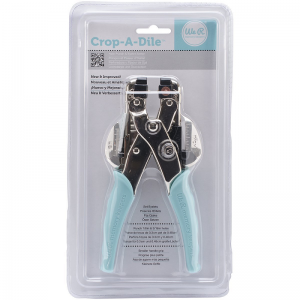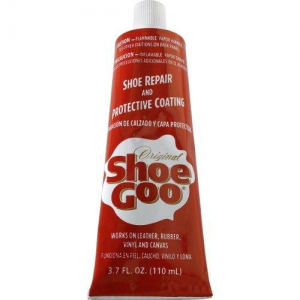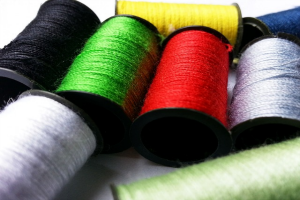 I am by no means a seamstress or a tailor, or even a sewing hobbyist. As a matter of fact, when it comes to sewing I often take as many shortcuts as I can. And for the most part, everything I know about repairing clothes comes from trial and error, and the 6 months I spent working at a Joanne Fabrics as a teenager; which is to say, my best efforts probably make your Aunt’s knitted Christmas sweater look like Armani.
I am by no means a seamstress or a tailor, or even a sewing hobbyist. As a matter of fact, when it comes to sewing I often take as many shortcuts as I can. And for the most part, everything I know about repairing clothes comes from trial and error, and the 6 months I spent working at a Joanne Fabrics as a teenager; which is to say, my best efforts probably make your Aunt’s knitted Christmas sweater look like Armani.
So I know what it takes to fix my clothing on the cheap. Is it pretty? Definitely not (though over the years I’ve gotten pretty good at disguising my sloppy techniques). But sometimes quality and appearance aren’t at the top of our priorities, and we need to get things fixed fast and cheap.
Especially in today’s world where mass-manufactured clothing is made to be cheap and for limited use. Shoes immediately come to mind for me, since I don’t drive very often. Most of the shoes you find in stores are catered to a Western population that doesn’t walk around very much anymore. As a result, someone like me who walks 2-4 miles a day will burn through a pair of tennis shoes in less than 6 months. I’d wager you can find similar standards with most affordable apparel.
So if you want to increase the longevity of these consumable goods that have become so commonplace in our society (thanks to Walmart, Target, Kmart, etc) it’s not worth it to spend a lot of money fixing them. Fortunately, there are some pretty cheap tools you can use to mend your clothes, and if you have any real experience, you’ll probably be able to make them look a lot better than my ramshackle garments.
Basic Sewing Kit
If you like to sew, you probably already have a sewing machine and a large selection of patterns, threads, and needles. But if you just need to do basic repairs, a simple travel size sewing kit is probably all you need. Personally, I prefer military kits, though I may be biased since I own a lot of military surplus clothing. Otherwise, an ordinary civilian kit will work just fine, and will probably include a dozen or so thread colors, needles, measuring tape, a thimble, and scissors.
Gorilla Glue
Wouldn’t it be great if you could just seal up your tattered fabrics with glue? There are so-called “no sew” fabric glues, but usually, these are only semi-permanent or are only designed to hold the fabric in place while you sew them. If you’re looking for real fabric glue, I’d recommend Gorilla Glue, which can also be used on wood, metal, and ceramic among other materials.
But in this case, you can definitely use it to mend fabric. Gorilla glue expands to about three times its size while it cures, so it’s not going to have any problem adhering to each individual thread, and since it’s waterproof it should be machine washable.
There are a few disadvantages though. It takes a little bit of practice to apply just the right amount, and if you’re dealing with really thin fabrics, there’s a good chance that it’s going to leave a dark spot where it dries. And since it gets pretty hard when it dries, it might chafe your skin a bit, so don’t use this on undergarments. I’d only recommend it for clothing that doesn’t come into constant contact with your skin, like jackets and loose jeans.
Lock Stitch Sewing Awl
If you have to repair leather, your standard sewing needle just isn’t going to cut it. You’ll need a sewing awl of some kind to punch through that hide. Personally, I like the lock stitch sewing awl. Unlike a normal awl, it doesn’t just puncture the leather. It adds a stitch to each hole and saves you a lot of time and hassle. You can see how it works here.
Eyelet Punch
For the most part, shoes are typically the only article of clothing to feature eyelets, but having an eyelet punch is still an incredibly useful tool to have. Not only can you fix blown out eyelets on your tennis shoes, but you can add some life to your old tarps and tents. I’ve chosen this particular model since it’s designed for eyelets that are 1/8″ in diameter; just enough to lace your paracord through.
Shoe Goo
I don’t think there is a single product on this list that is as simple and versatile, as shoe goo, and it should be your go-to substance for fixing any kind of damage that your shoes might sustain. Much like Gorilla Glue, it cures into a very hard substance, but also has some flexibility as well. This is really important for shoes since pretty much every part of your footwear is subject movement and friction. You can use it to reattach or replace treads, seal edges that leak rainwater, and fasten frayed shoelaces. And like everything else on this list, it’s an affordable alternative to throwing away and replacing your gear.
This article was originally published at Ready Nutrition™ on February 12th, 2015


